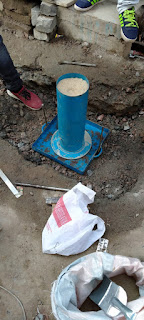Wind Power (Step By Step Procedure):- A Case Study
.jpeg)
.jpeg)
Field Dry Density By Sand Replacement Method
 |
| Image Source :Indiamart.com |
Required Apparatus-
(1.) Rapid moisture meter
(2.) Weight balance
(3.) Sand pouring cylinder
(4.) Metal tray with centre hole
(5.) Measuring scale
(6.) Cutting and excavating tools
(7.) Metal tray
(8.) Sand clean and uniform passing 1mm IS sieve and retained on 600 micron IS sieve.
Recent Blog: Specific gravity and water absorption of coarse aggregate
 |
| (Image Credit: Ritesh Raj) |
Test Procedure-
(1.) Take the weight of sand and sand pouring cylinder before pouring leaving a gap of 10 mm from the top. Suppose Wt=17110 gm. Note this weight in format.
(2.) Take the metal tray with hole and place the metal tray with central on levelled surface and excavate a hole in soil in pavement layer through the opening in the tray with depth of 150 mm.
(Image Credit: Ritesh Raj)
(3.) Excavation will be in vertical position and excavated soil will kept in the same tray.
(4.) Collect all excavated material carefully in another metal tray and record its weight and mention in the format. Weight=4048 gm
(5.) Place the sand pouring cylinder directly over the excavated hole and allow the sand to passes into the hole by opening the shutter of cylinder.
 |
| (Image Credit: Ritesh Raj) |
Also Read: Water absorption test test of an aggregate
(6.) Close the shutter when further movement of sand is not seen.
(7.) Record the weight of sand pouring cylinder after pouring sand. Weight=13210 gm
(8.) Measure the moisture content of soil by speedy (rapid) moisture meter.
(9.) Now take sample 6 gm and calculate moisture content. Moisture content=8.5 %
 |
| (Image Credit: Ritesh Raj) |
(10.) Take moisture content through the calibration chart=8.36 %
(11.) Now, consider for calculation.
Weight of sand in hole=Weight of cylinder filled with sand before pouring-Weight of cylinder filled with sand after pouring -Weight of cylinder in cone
=17110-13210-1253
=2647 gm
 |
| (Image Credit: Ritesh Raj) |
Also Read: Compressive strength of brick
(12.) Volume of hole=Weight of sand in hole/Bulk density of sand
= 2.647/1.372
= 1929.3
 |
| (Image Credit: Ritesh Raj) |
(13.) Wet density of sample=Weight of wet sample from hole/Volume of hole
= 4048/1929.30
= 2.098
(14.) Bulk density of sample =Wet density of sample/(1+ moisture content)
= 2.098/(1+8.36%)
= 1.936
 |
| (Image Credit: Ritesh Raj) |
(15.) Relative degree of compaction=Dry density of site sample/Laboratory MDD of sample*100
= 1.936/1.970 *100
= 98.29 %
Also Read: Fineness test of cement
Format:-
|
Source of Material : |
Date of Testing : |
||||||||||||
|
Bulk density of sand=1.372 |
|||||||||||||
|
Weight of sand in cone (W3)=1253 gm |
|||||||||||||
|
MDD(gm/cc) (Ymax)=1.970 |
|||||||||||||
|
OMC (%)=8.33 |
|||||||||||||
|
Compaction required= |
|||||||||||||
|
Sl.
No. |
Description
|
1 |
2 |
3 |
4 |
5 |
6 |
||||||
|
A. |
Test hole no. |
|
|
|
|
|
|
||||||
|
B. |
Laboratory Test |
|
|
|
|
|
|
||||||
|
C. |
Depth of hole (mm) |
150 |
|
|
|
|
|
||||||
|
D. |
Weight of wet sample from hole (gm) (Ww) |
4048 |
|
|
|
|
|
||||||
|
E. |
Weight of cylinder filled with sand before pouring (gm) (W1) |
17110 |
|
|
|
|
|
||||||
|
F. |
Weight of cylinder filled with sand after pouring (gm) (W2) |
13210 |
|
|
|
|
|
||||||
|
G. |
Weight of sand in hole (gm) (Ws=W1-W2-W3) |
2647 |
|
|
|
|
|
||||||
|
H. |
Volume of hole (cc)
V=Ws/Gs |
1929.3 |
|
|
|
|
|
||||||
|
I. |
Weight density of sample (gm/cc) Yd=Ww/V |
2.098 |
|
|
|
|
|
||||||
|
J. |
Rapid moisture meter ID |
1 |
|
|
|
|
|
||||||
|
K. |
Moisture content by Rapid moisture content |
8.5 |
|
|
|
|
|
||||||
|
L. |
Corrected moisture content (%) (W) |
8.36 |
|
|
|
|
|
||||||
|
M. |
Dry density of sample (gm/cc) |
1.936 |
|
|
|
|
|
||||||
|
N. |
Relative degree of compaction(%)=Yd/Ydmax |
98.29 |
|
|
|
|
|
||||||
Has this page been helpful to you? If yes, please mention in the comment box.
Comments
Post a Comment
If you have any suggestions and doubts please let me know.